
|
 |
 |
 |
 |
 |
EGG‑NEWS.com
Egg Industry News, Comments & More by
Simon M.Shane
|
 |
 |
 |
 |
 |
 |
Editorial
Rising Energy Costs to Offset Trend in Deflation?
|
04/23/2024 |
|
 Following eleven successive increases in the 10-year benchmark interest rate the FOMC engineered a reduction in U.S. inflation as measured by the Consumer Price Index (CPI) from 8.9 percent in June 2022 to 3.5 percent in March 2024. The increase in the benchmark interest rate did not result in unemployment and many influential economists predict a “soft landing”. Following eleven successive increases in the 10-year benchmark interest rate the FOMC engineered a reduction in U.S. inflation as measured by the Consumer Price Index (CPI) from 8.9 percent in June 2022 to 3.5 percent in March 2024. The increase in the benchmark interest rate did not result in unemployment and many influential economists predict a “soft landing”.
Despite the substantial increase in the inflation rate, attaining an elusive FOMC inflation target of approximately 2.0 percent will be difficult to accomplish. At the beginning of year, the market anticipated as many as six reductions in interest rates. The five consecutive pauses suggested caution and based on CPI, wage and employment data there will probably be only one or two reductions of 0.25 percent each in 2024 and not before late summer. Federal Reserve Chairman Powell, supported by Federal Reserve Governors, has stated in Congressional testimony and in public statements that decisions on reducing interest rates would be based on data with demonstrable progress in reducing inflation.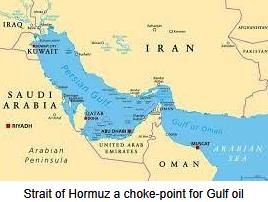
Energy is a major contributor to “sticky” inflation having increased by close to 25 percent since December 2023. Although turbulence in the Middle East could have been a significant factor in the increase, effectively disciplined restriction in output by OPEC+ has maintained price above $80 per barrel. As noted in successive weekly Economy, Energy and Commodity Reports in EGG-NEWS, the November reduction in OPEC+ output of 2.2 million barrels a day was extended through June representing two percent of global production. Non-OPEC output including Brazil, Angola and the U.S. has in large measure moderated the effect of the OPEC+ constraints. OPEC+ has learned that high oil prices reduce demand, and the Cartel has acquired the skill and discipline to fine-tune supply to regulate price and to disfavor alternative sources of energy.
Restoration of the economies of the E.U. and China, concurrent with increased industrial activity, will however create further demand for crude and other forms of non-renewable energy with valid predictions of a rise in price. Despite the reciprocal mutual attacks by Israel and Iran during the current month, the Brent Crude benchmark is still below $90 per barrel compared to a high of $95 in August 2023 and a recent low of $75 per barrel during November 2023. Economists predict that if OPEC cuts hold, Brent Crude could reach $100 per barrel by mid-summer attributed to increased demand.

Unknowns relating to future oil supply and prices will be influenced by possible reaction by Iran. Obviously increased sanctions against the regime will evoke a response either by the rulers of that nation or their surrogates. Interdicting transport of crude through the straits of Hormuz or additional action by Houthi rebels in the Bab-el-Mandeb strait could drive oil above $100 per barrel. This would result in international action including pressure by China, the major purchaser of Iranian oil. Given recent history, it is anticipated that Brent Crude will fluctuate between $85 and $90 per barrel though summer. Availability of domestic supply in the U.S. will probably constrain WTI crude at between $82 and $87 per barrel but higher prices will favor increased exports.
Since the price of oil is closely correlated with corn and other agricultural commodities, any escalation in price has implications for livestock production. Higher prices for diesel and gasoline will limit consumer spending with a negative effect on the earnings of food producers, distributors and retailers. According to the American Automobile Association
U.S. consumers paid on average, $3.66 per gallon for regular grade during mid-April.
It is axiomatic that the pump price of gasoline will influence the November election with high prices attributed to the incumbent party, irrespective of justification.

|
PEAK 2024 an Outstanding Success
|
04/16/2024 |
|
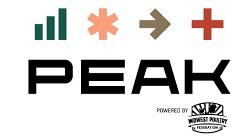 PEAK 2024 organized by the Midwest Poultry Federation is now well established in the Minneapolis Convention Center that provides more exhibition space, meeting rooms and hotel accommodation that the previous St. Paul location. The trade exhibition consistently attracts more egg-related allied suppliers compared to the IPPE. The concurrent industry association meetings and educational programs are focused on egg production given the concentration of farming operations in six Midwest states. Although space limits the display of large displays including 700-case per hour graders and a range of aviary equipment, technical personnel are available on booths to discuss operational parameters supplemented by videos, models, components and short cross-sections of installations. PEAK 2024 organized by the Midwest Poultry Federation is now well established in the Minneapolis Convention Center that provides more exhibition space, meeting rooms and hotel accommodation that the previous St. Paul location. The trade exhibition consistently attracts more egg-related allied suppliers compared to the IPPE. The concurrent industry association meetings and educational programs are focused on egg production given the concentration of farming operations in six Midwest states. Although space limits the display of large displays including 700-case per hour graders and a range of aviary equipment, technical personnel are available on booths to discuss operational parameters supplemented by videos, models, components and short cross-sections of installations.
 Educational programs presented included the North Central Avian Disease Conference, the Organic Egg Farmers of America Symposium, the Devenish Nutrition Symposium, and a number of informal gatherings taking advantage of attendance at the event. Educational programs presented included the North Central Avian Disease Conference, the Organic Egg Farmers of America Symposium, the Devenish Nutrition Symposium, and a number of informal gatherings taking advantage of attendance at the event.
The Midwest Poultry Federation arranged a series of educational presentations for pullet and egg management, feed technology and business leadership. During the trade exhibition, poultry TED Talks were presented detailing innovations in products and management for the benefit of attendees. Entertainment included PEAK Unhatched, an Exhibition-floor Happy Hour and Hospitality Night.
Despite the prevailing favorable margins in egg production, there were a number of overhangs that detracted from optimism:
- The resurgence of highly pathogenic avian influenza with three complexes affected since the beginning of April requiring depopulation of close to six million hens in two states was the major issue of concern. It is evident that HPAI is no longer limited to seasonal epornitics but has expanded beyond the migration of waterfowl in spring and fall months. This is in all probability due to transfer of the H5N1 virus to non-migratory species of free-living birds. This is evidenced by dead grackles and pigeons yielding H5N1 virus in the vicinity of the index dairy farm in Texas that was affected with Bovine Influenza-H5N1. Outbreaks of HPAI have been regularly diagnosed on a weekly basis in backyard flocks in diverse states outside the migratory seasons. These small flocks serve as sentinels for the presence of avian influenza virus and many cases are not diagnosed. Sometime in 2024 the USDA-APHIS will have to accept regional vaccination for turkeys and egg-production flocks. It must be obvious by now that it is futile to attempt to eradicate an endemic infection spread by the aerosol route in addition to fomites.
- The impasse in Congress is impeding passage of legislation necessary to maintain agricultural production. The Farm Bill is mired in dissent in both the Senate and House Agricultural Committees with polarization separating left and right-leaning members. Ultimately there will have to be compromise on the two issues of contention represented by allocations for SNAP and WIC favored by the left and diversion of funds from climate change programs to commodity price support on the right. The 118th Congress has barely passed fifty bills as opposed to an anticipated 400 in a normal two-year period. Appropriations bills were delayed by months by resorting to stop-gap continuing resolutions. Both parties are to blame for their lack of commitment to the national interest caused by grandstanding and intra-party conflict.

- There was considerable talk in the hallways at PEAK of consolidation in the retail food sector. The proposed merger between the Kroger Company and Albertsons Corporation is a concerning issue since this would create more buying power for the chains that are readily able to adjust orders to influence the industry benchmark price discovery system to the disadvantage of producers.
- There are concerns over the economy. The Federal Reserve has obviously reduced inflation from 8.9 to 3.5 percent but is experiencing difficulty in reducing levels to the target of 2.0 percent. International conflict and the price of energy are adding to the burden of inflation that is reducing consumer spending despite the last hurrah of extravagance during the first quarter of 2024.
- As in all planting seasons, there is concern over the anticipated crop. With the projected cyclic transition from a La Nina to an El Nino event, weather patterns during the 2024 growing season will influence yields. Lower feed prices have contributed to positive margins over the past twelve months but an unfortunate combination of higher input costs with production exceeding demand may impact profitability in the late third and early fourth quarters.
It is hoped that the contributions derived from PEAK 2024 in the form of technical and trade information will be transferred from the event to all U.S. production units and companies with evident improvements in productivity and profitability.

|
Relative Cost of Groceries
|
04/04/2024 |
|
 Dr. Leo Feler, Chief Economist at Numerator, recently published on prices of groceries and their affordability. During January 2020, that marked the beginning of the COVID years, through December 2023, the cost of at-home food rose by an average of 25 percent. Income, however, increased 24 percent over the same period, offsetting the average rise in shelf prices. Dr. Leo Feler, Chief Economist at Numerator, recently published on prices of groceries and their affordability. During January 2020, that marked the beginning of the COVID years, through December 2023, the cost of at-home food rose by an average of 25 percent. Income, however, increased 24 percent over the same period, offsetting the average rise in shelf prices.
Dr. Feler documented an increase in price for food categories over the four-year period with poultry, fish and eggs increasing at 26 percent and the lowest category, dairy and related products, at 21 percent. His predictions are for stability in price going forward with low, single-digit increases paralleling the situation before COVID that resulted in difficulties in the supply chain.

Despite the economic reality that grocery items are as affordable now as they were in 2020, there is a perception that prices are higher. This is evidenced by recent comments from the White House relating to “price gouging” and “shrinkflation” and echoed in statements by the Federal Trade Commission.
Consumers have adapted to higher prices by searching for value, hence, the rise in popularity of house brands. Surveys showed that forty percent of consumers are buying more private brands and reducing expenditure on unnecessary food items. They are also buying in bulk as reflected in the reported revenue of Costco, Sam’s Club and B.J.’s. Consumers are also calculating cost per unit and splitting their grocery purchases among competing stores to take advantage of special offers.
According to Steve Markenson, Vice-President of Research at the Food Marketing Institute, consumers are now considering convenience and quality in addition to cost in evaluating items. The deep discounters, led by Aldi, have obviously benefited through low operating costs, limited range of SKUs and demonstrably lower prices based on their private ownership and business model.

It is evident that retailers that can negotiate favorable prices from their suppliers contributes to higher gross margins and improvement in the bottom line. This only benefits consumers if there is a pass-through of savings. The check-out point and the print-out of the transaction either reinforces or dispels the perception of value.

Dr. Leo Feler, Chief Economist, Numerator Inc. |
Given the increase in eat-at-home, and with increased concern over the price of groceries, promotion of eggs should emphasize value. This includes an emphasis on nutrient content against alternatives including dairy, red meat and plant-based alternatives. Since the expanded concept of value incorporates convenience and ease of preparation, the American Egg Board should address the inherent attributes of eggs and develop a “not just for breakfast” message. Food manufacturers should be encouraged to incorporate egg-derived products in foods and develop a range of snacks and meal presentations featuring eggs as a source of high-quality protein with limited caloric contribution to diets.

|
Scientific Realities Should Moderate Official Statements on Avian and Bovine Influenza
|
04/04/2024 |
|
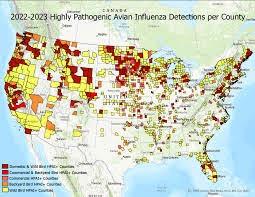 To date, APHIS has been factual in their minimal reporting on the ascending incidence of bovine influenza-H5N1. In contrast, a number of State Veterinarians have been far more optimistic in their official statements dampening concern over the potential of the virus to become zoonotic. To date, APHIS has been factual in their minimal reporting on the ascending incidence of bovine influenza-H5N1. In contrast, a number of State Veterinarians have been far more optimistic in their official statements dampening concern over the potential of the virus to become zoonotic.
 The major concern is the possible emergence of a zoonotic strain of H5N1 as noted by the World Health Organization that regards the virus as a potentially pandemic strain requiring surveillance over a range of avian and mammalian species. At this time, there is no evidence that spontaneously altered strains of H5N1 are infectious to humans although affecting a wide range of terrestrial and marine species with evident animal-to-animal spread. Despite the recovery of H5N1 virus from a dairy-herd employee with conjunctivitis, the only previous U.S. case occurred in a worker involved in depopulation of an infected flock. Given thousands of worker hours of exposure in 2015 and then again during the 2022-2023 epornitics, one asymptomatic case suggests that even with extreme exposure, humans are currently refractory to infection. The major concern is the possible emergence of a zoonotic strain of H5N1 as noted by the World Health Organization that regards the virus as a potentially pandemic strain requiring surveillance over a range of avian and mammalian species. At this time, there is no evidence that spontaneously altered strains of H5N1 are infectious to humans although affecting a wide range of terrestrial and marine species with evident animal-to-animal spread. Despite the recovery of H5N1 virus from a dairy-herd employee with conjunctivitis, the only previous U.S. case occurred in a worker involved in depopulation of an infected flock. Given thousands of worker hours of exposure in 2015 and then again during the 2022-2023 epornitics, one asymptomatic case suggests that even with extreme exposure, humans are currently refractory to infection.
Although there have been over 800 documented cases of H5N1 or H7N9 influenza among humans in Asia over two decades, the attack rate is exceptionally low given the level of potential exposure since emergence of these strains in poultry. Most of the cases involved either the elderly or the immunosuppressed. Patients in most instances presented with a history of contact with live poultry either on farms or in wet markets as with the two cases documented in South America in 2023.
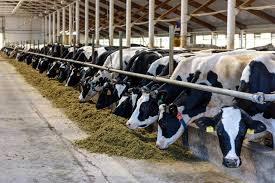
Given the reality that migratory marine birds and waterfowl are susceptible to H5N1 and disseminate the virus across five continents, ultimately, mutations may occur that may result in a zoonotic strain. The higher the concentration of susceptible birds or livestock in an area or on a farm, the greater will be the probability of either a mutation or a recombinant event.
Accordingly, it would be advisable to consider human health as a justification to create non-susceptible commercial bird populations through immunization. Currently, archaic and inappropriate trade restrictions in addition to the imposition of contrived trade barriers disfavor universal adoption of vaccination. The World Organization of Animal Health supports the principle of vaccination and clearly states that this modality should not be a restraint to trade providing there is adequate surveillance to detect infection in immunized flocks. In the age of PCR, this is an achievable objective. It will be possible for regulator y authorities to introduce and manage a program of certification to confirm that export consignments are derived from flocks free of infection. y authorities to introduce and manage a program of certification to confirm that export consignments are derived from flocks free of infection.
The concerns of the broiler segment of the U.S. poultry industry concerning vaccination are recognized. When human health is considered, the potential of losing export sales pales in significance to even the slightest risk of an emerging pandemic. The cost of COVID with the attendant loss of more than one million of our fellow citizens suggests that H5N1 avian influenza is more than just a “chicken and turkey problem”.
It is now time to implement regional vaccination against HPAI in areas with a history of infection and specifically for turkey and egg-production flocks. The associations representing the segments of the U.S. poultry industry, APHIS, USAPEEC and the Office of the U.S. Trade Representative need to coordinate and intensify their activities to accept rigorously controlled vaccination. As far as possible, issues relating to restraint in trade based on vaccination should be resolved given that HPAI is now panornitic in distribution.
A statement by a mid-west State Veterinarians that “research to date has shown that mammals appear to be dead-end hosts which means that they are unlikely to spread HPAI further” is simplistic and is devoid of substantiation by either current virology or epidemiology. State Veterinarians are tasked with preserving the health of flocks and herds under their jurisdiction and should not be cheer-leaders for consumption of livestock products. With respect to HPAI, there is more at risk than either loss of trade or the cost of depopulation. Creating a solidly immune population of commercial poultry would contribute to a lower risk of facilitating a zoonotic strain of avian influenza. The emergence of bovine influenza-H5N1 in March and outbreaks in mink and marine mammals should be a warning of the potential for an influenza pandemic reminiscent of the 1918-1919 catastrophe. Risks of mutation might be small but economic and humanitarian consequences are infinite.

|
FTC Report Implicates Large Grocery Chains in Food Inflation
|
03/25/2024 |
|
 A March 21st report issued by the Federal Trade Commission (FTC) identified the involvement of major retail grocery chains in food inflation following supply chain disruptions coincident with the COVID years. The report analyzed the actions of producers, wholesalers and retailers in “skyrocketing prices for groceries” that impacted consumers. A March 21st report issued by the Federal Trade Commission (FTC) identified the involvement of major retail grocery chains in food inflation following supply chain disruptions coincident with the COVID years. The report analyzed the actions of producers, wholesalers and retailers in “skyrocketing prices for groceries” that impacted consumers.
The report demonstrated that larger chains benefitted at the expense of smaller competitors. The focus of the report included Walmart, Amazon, Kroger, C&S Wholesale Grocers, Proctor and Gamble, Tyson Foods, Kraft-Heinz and Associated Wholesale Grocers Inc. The FTC report demonstrated the power of major retailers and their impact on the supply chain based on buying power to the disadvantage of smaller, regional grocery chains.
 The FTC report documented that large retailers increased their revenue by more than six percent in relation to costs during 2021 through 2023 without commensurate increases in operating expenses. The report also documented pressure on suppliers relating to prices and delivery. The FTC report documented that large retailers increased their revenue by more than six percent in relation to costs during 2021 through 2023 without commensurate increases in operating expenses. The report also documented pressure on suppliers relating to prices and delivery.
The report was welcomed by the National Grocers Association (NGA), representing independent and small stores. Chris Jones, the Chief Government Relations Officer for the NGA, noted the past failure of the FTC and DOJ to use existing legislation to suppress pricing decisions that disfavor consumers and small suppliers. The NGA president, Greg Ferrara, stated, “Decades of lax antitrust enforcement enables grocery buyers to coercively squeeze suppliers to comply with their trade demands, unfairly disadvantaging smaller competitors”.
The Robinson-Patman Act specifically disallows both discriminatory and predatory pricing. Buyers who benefit from these practices violate the Act if the buyer pressures producers to agree to lower prices for commodities of similar grade and quality. This would apply specifically to generic USDA graded eggs that are a commodity in interstate commerce.
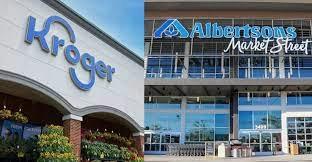 The FTC report coincides with a lawsuit intended to block the merger of the Kroger Company with Albertsons Corporation. The Administration recognizes the political benefits of consumer protection in a pre-election year. Notwithstanding the intensified enthusiasm for anti-corporate action, it must be recognized that egg producers have been nickeled and dimed by the major chains over decades. This has reduced margins and deprived producers of sufficient profit to re-invest in maintenance and expansion. An added burden with less than adequate reimbursement is represented by the need to convert housing from conventional cages to alternative systems since 2020 to comply with welfare requirements. The FTC report coincides with a lawsuit intended to block the merger of the Kroger Company with Albertsons Corporation. The Administration recognizes the political benefits of consumer protection in a pre-election year. Notwithstanding the intensified enthusiasm for anti-corporate action, it must be recognized that egg producers have been nickeled and dimed by the major chains over decades. This has reduced margins and deprived producers of sufficient profit to re-invest in maintenance and expansion. An added burden with less than adequate reimbursement is represented by the need to convert housing from conventional cages to alternative systems since 2020 to comply with welfare requirements.
The situation in the U.K. parallels the findings of the FTC with regard to pressure on producers. As with the U.S retail grocery in the U.K. is an oligopoly with a few retailers sourcing domestic-produced and some imported shell eggs. After Brexit feed and energy costs soared but retailers failed to adjust prices to allow independent producers of free-range eggs, comprising half of national supply, to reach break-even. The result was a sharp decline in availability as producers ceased operation due to exhausting working capital and credit. Eventually many of the large chains were obliged to make ex gratia payments to individual producers to restock housing and to resume production.
 The wholesale price of packed generic eggs in the U.S. should be subject to the law of supply and demand. Cyclic periods of oversupply that were a feature of the 1980s through the 2010s have given way to a more rational rate of expansion following consolidation, conversion to non-caged housing and more reliable market intelligence. Unfortunately the prevailing industry benchmark reporting service now appears to function to the detriment of producers. The daily quotations appear to amplify downward movement in price and allows chain buyers the opportunity to depress prices over the short term by temporarily withholding orders. This results in a disproportionately low price, exacerbating price elasticity. A Midwest-large Chicago Mercantile Exchange (CME) quotation would be more equitable given that the costs of corn and soybean meal representing 65 percent of nest run expense is determined by the CME. The wholesale price of packed generic eggs in the U.S. should be subject to the law of supply and demand. Cyclic periods of oversupply that were a feature of the 1980s through the 2010s have given way to a more rational rate of expansion following consolidation, conversion to non-caged housing and more reliable market intelligence. Unfortunately the prevailing industry benchmark reporting service now appears to function to the detriment of producers. The daily quotations appear to amplify downward movement in price and allows chain buyers the opportunity to depress prices over the short term by temporarily withholding orders. This results in a disproportionately low price, exacerbating price elasticity. A Midwest-large Chicago Mercantile Exchange (CME) quotation would be more equitable given that the costs of corn and soybean meal representing 65 percent of nest run expense is determined by the CME.
Examination of pricing policies of large grocery chains by the FTC is long overdue and was in all probability a byproduct of the investigation of the proposed Kroger merger (or acquisition) with Albertsons. This transaction would be detrimental to suppliers, workers and consumers as evidenced by lawsuits filed by the Attorneys General of eight states and the FTC.

|
U.S. Economy Currently Strong – But Will it Last?
|
03/19/2024 |
|
It is axiomatic that a strong U.S. economy is beneficial for the poultry industry. Availability of capital allows for investment in expansion and installation of equipment that promotes efficiency. Increased spending power encourages consumption reflected in higher demand and margins. At the end of the first quarter of 2024, the U.S. economy is strong but is vulnerable to inappropriate fiscal policy and political pressures. Over the past five years, the U.S. economy has grown eight percent in real terms compared to the E.U. at three percent, Japan at one percent and negative growth among other nations.
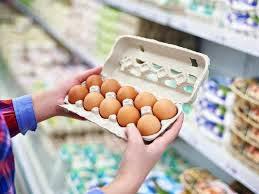
Despite successive rate increases as determined by the Federal Reserve FOMC, unemployment has remained at an exceptionally low level, currently 3.9 percent and the economy is moving towards a “soft landing”. Economists suggest that despite proving “sticky” inflation should decline to approximately 2.2 percent on an annual basis by the end of 2024 with a concurrent forecast of a 3.2 percent growth in GDP. This, in large measure, has been achieved through increased productivity with a 2.6 percent increase in the non-farm categories and 0.6 percent overall.
The U.S. achieved the current, favorable position through injection of capital during the immediate post-COVID years. This largesse was accompanied by an average deficit of 14 percent of GDP in 2020 and 2021 compared to less than half this level among Euro nations. Other factors contributing to a favorable situation include energy independence and the relatively low cost of the range of fuels used compared to the E.U. The labor force has increased to approximately 160 million workers, up four percent from 2019. This has been driven by immigration with the foreign-born component up by 16 percent since the advent of COVID. Despite immigration, unemployment is at a low level under 4 percent with 10 million positions open albeit with moderate wage increases.

Despite the current favorable situation, there are certainly clouds on the horizon. Stimulation of the economy through government spending is widening the national deficit. In 2022, the deficit was 4.0 percent of GDP but rose to 7.5 percent in 2023. The nation is now spending as much on annual interest as it does on defense. One concern is the high proportion of debt held by China that is experiencing a decline in their economic growth and the holdings by other “unfriendly” nations. Problem areas include delinquency on credit cards suggesting that consumer spending, a major driver of the economy, will falter. This is despite the fact that high-income consumers representing 20 percent of earners are responsible for 45 percent of consumption. It is inevitable that this demographic will tighten their purse strings. Restrictive climate-related legislation is imposing costs on the economy. As an example the U.S. is currently the world's largest supplier of LNG. Executive orders limiting expansion of export terminals will be detrimental to reversing the foreign trade deficit. The property market appears vulnerable to sustained high interest rates and post-COVID factors including work-from-home have reduced occupancy rates for commercial property that cannot be converted to housing to provide an equivalent return. This may reflect on the stability of regional banks that are vulnerable to now questionable security and the performance of their loan portfolios.
Of greatest concern will be the policies implemented by the eventual winner of the 2024 Presidential election. The opposing candidate is expressing views that promise extreme protectionism with high tariffs. This would be detrimental to the economy. Concurrently an anti-immigration bias would deprive U.S. industry of necessary workers. Interference in the independence of the Federal Reserve would also be detrimental to the standing of the U.S. as evidenced by the economies of nations such as Turkey where injudicious political pressure over interest rates has proven disastrous to the value of the Nation’s currency. Promises to lower taxes if they eventuate will markedly reduce revenue and widen the national debt as has occurred under the present and previous Administrations.
The incumbent candidate is promising to raise taxes on corporate earnings and on high-income earners who are the most innovative and productive. In many respects the programs to be implemented are also protectionist although it is questioned as to whether pronouncements during the 2024 State of the Union address were political rhetoric or a firm intention of policy during a second term. The proposed program of spending would intensify the magnitude of the national debt. Attempts to reverse climate change would have profound impacts on the energy industry, vital to the economy. Injudicious spending on social programs will add to the national debt especially if “investment” is not realized over the short or even intermediate term.
Policies and programs implemented by the USDA in recent years using funding from the CARE Act that are intended to encourage local production and assist the “disadvantaged and under-represented” may not even contribute to intermediate-term productivity. Attempts to restructure the meat industry are quixotic and contrary to the realities of economies of scale and efficiency. From the perspective of providing inexpensive protein, oligopolies should be tolerated with appropriate protection for farmers, given the needs to supply the domestic and export markets, some of which are eroding.
Despite the favorable economic situation as quantified each week in the EGG-NEWS Economy, Energy and Commodity Report, some changes will be necessary to ensure a “soft landing” as anticipated. Both candidates for the Presidency should now moderate their rhetoric and adopt acceptable and productive economic policies based on sound economic principles. The Federal Reserve should address the issue of the delay in reducing interest rates given the trajectory in the decline in inflation to three percent. It is noted that eleven previous cycles of suppressing inflation by increasing interest rates, the economy entered into recession ten times. A repetition could be averted by three rate cuts from June onwards. Currently, the economy is in good hands. Let us hope prudence and sound judgment resist the temptation to impose isolationism or to continue with intemperate government spending, throttling the energy industry and failing to introduce a rational program of immigration. Hopefully, politicians and economists will see common ground and continue to guide the progress of our Nation for the benefit of both producers and consumers.

|
Corporate Greed and Shrinkflation Emerging as Unjust Election Issues
|
03/12/2024 |
|
Despite the fact that inflation is receding, there is both perception and reality that the prices of food items have not declined in proportion to other items. Deflation has, in large measure, been a reflection of the lower cost of energy although it is generally accepted that a gas price above $3.25 impact budgets and influences voters more than fluctuation in the price of a dozen eggs or a pound of ground beef. In actuality inflation as measured by the Consumer Price Index has declined from 8.9 percent in June 2022 to 3.2 percent in February 2024.
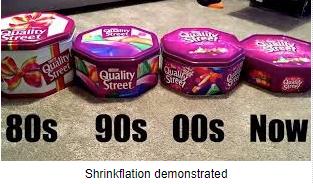
It is apparent that the Presidential re-election campaign will involve messages implying that the food manufacturing and distribution sectors are indulging in “corporate greed” and that prices are unnecessarily high and that unscrupulous companies are employing shrinkflation for packaged goods. This was emphasized in the 2024 State of the Union address and according to polling, resonates with the electorate.

Inflation was an inevitable result of injecting trillions of dollars into the economy in response to the emergence of COVID with widespread disruption of production capacity and consumption. Economists including ex-Treasury Secretary, Larry Sumner warned of the effect of inflation, but this was to be a price to pay to avoid a depression. We did not have soup and breadlines on Wall street or Hoovervilles on the Mall but we still have homelessness and SNAP. Through skill and a measure of luck, the Federal Reserve has guided the economy over the past three years to what is forecast to be a “soft landing” without resulting in mass unemployment. Compared with other industrialized nations, the U.S. has emerged from the pandemic with a relatively strong economy as measured by gross domestic product, with Q4 GDP at 3.2 percent, low unemployment of 3.9 percent in February 2024 and increasing agricultural and industrial productivity.
The Administration message that the food production sector is taking advantage of consumers is incorrect and unjustified. While there may be isolated cases of overt shrinkflation or price gouging, profit margins generated by food producers are consistent with restraint in pricing that is expected in a free market and competitive economy.
 Political rhetoric conveniently forgets the twenty percent increase in wage rates over the past five years. This is reflected in all components of the food production chain from field workers through to serving. Quoted in Politico, Dean Baker a Senior Economist at the right leaning Center for Economic and Political Research, stated, “We are not going to have a world where people get to keep their 20 percent pay increases and pay what they did four years ago for food. Political rhetoric conveniently forgets the twenty percent increase in wage rates over the past five years. This is reflected in all components of the food production chain from field workers through to serving. Quoted in Politico, Dean Baker a Senior Economist at the right leaning Center for Economic and Political Research, stated, “We are not going to have a world where people get to keep their 20 percent pay increases and pay what they did four years ago for food.
The largesse exhibited during the COVID period comprising Federal funding through the Coronavirus Aid, Relief in Economic Security (CARES) Act of 2020 and the American Rescue Plan of 2021 in all probability averted a depression. Not even the U.S. government can realistically spend the artificial money created. Various Departments including the USDA still hold undistributed funds that should be returned to the Treasury to offset the national debt. Funds made available to the Department of Agriculture have been misused in futile attempts by Secretary Tom Vilsack to restructure protein production. He has consistently attempted to oppose the major packers and broiler integrators through new regulations under the Packers and Stockyards Act. He has distributed vast sums to unproductive projects claiming support for the “disadvantaged and underrepresented” in agriculture. The scale of USDA “giveaways” has intensified this year possibly because administrators and initiators of programs recognize the likelihood of a change in administration that would bring about an end to their activities.
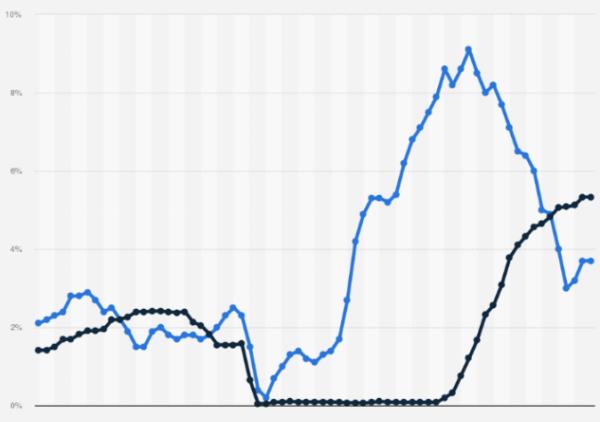
Inverse relationship between ascending Fed rate and deflation |
It is unfortunate that the agricultural sector and the food industry have become targets of political rhetoric through unjust accusations of corporate greed. The Administration has attempted to divert criticism from current disaffection to focus on an essentially innocent industry. This is confirmed in the March 12th release of the Consumer Price Index that documented a 2.2 percent increase in all food on an annual basis with food-at-home up 1.0 percent and food-away-from-home up 4.5 percent, reflecting labor costs.
Given that alleged price gouging and corporate greed will be emphasized as talking points in the coming election campaign, industry associations should prepare rebuttals and be able to counter unjust accusations, applying sound reasoning supported by economic facts.
Subscribers are directed to the Economy Section of the weekly Economy, Energy and Commodity Report in this edition.

|
U.S. Agriculture Needs a Workable Immigration Law
|
03/07/2024 |
|
 With the apparent failure of the Immigration Bill previously agreed to in principle by both chambers of Congress, the U.S. will continue to function with legislation passed in 1990. Although agricultural workers can enter the U.S. on H-2A visas, there is a general agreement among many sectors of agriculture including dairy, produce and fruit that the allocation is inadequate. Foreign workers can be legally employed providing they comply with E-Verify requirements. There is evidence that the system of verification is being gamed with both deceptive documentation and widespread overlooking of the requirement. With the apparent failure of the Immigration Bill previously agreed to in principle by both chambers of Congress, the U.S. will continue to function with legislation passed in 1990. Although agricultural workers can enter the U.S. on H-2A visas, there is a general agreement among many sectors of agriculture including dairy, produce and fruit that the allocation is inadequate. Foreign workers can be legally employed providing they comply with E-Verify requirements. There is evidence that the system of verification is being gamed with both deceptive documentation and widespread overlooking of the requirement.
It has become politically expedient for some state administrations to pass legislation enforcing E-Verify. Florida enacted SB1718 that impacts approximately 750,000 undocumented immigrants working in the state, mainly in agriculture but also construction and tourism. What initially appeared to be a popular but discriminatory law has now emerged as a restrictive measure notwithstanding the reliance of Florida and other states on foreign labor. Both farming and business communities are experiencing difficulty in recruiting and retaining workers many of whom are undocumented. The law mandating E-Verify resulted in an exodus of workers from the state fearing deportation. SB1718 also serves as a license to exploit through wage theft, harassment and substandard accommodation given that workers are captive under illegal employment and have no legal recourse.
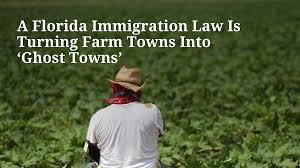
Attempts to enforce E-Verify in Florida resulted in protests from agricultural associations and the state Chamber of Commerce with a movement to have SB1718 rescinded given the negative economic impact. Some states including North Carolina have enacted loopholes exempting agriculture and specified industries from nominal compliance with E-Verify. Studies on the effect of enforcing E-Verify suggest profound economic loss as in Georgia in 2011 when undocumented workers left the state, resulting in a decline in agricultural revenue exceeding $100 million.
Politicians endorsing E-Verify point to the need to preserve jobs for U.S. citizens. If there were sufficient applicants from our under- and unemployed residents for available but relatively low-paid agricultural and construction positions in Florida, California and the Carolinas, there would not be a demand for foreign workers. It is questioned why the U.S. expends public funds on SNAP and unemployment benefits when jobs are available.
 It is clear that the current look-the-other way approach to E-Verify favors agriculture, construction and tourism. There is a ready supply of both illegal and documented workers willing to labor for statutory minimum or sub-minimum wages. If foreign workers were not available, wage rates would rise possibly attracting unemployed U.S. workers. At some point, there will have to be a balance between legal entry with work offered at minimum wage rates coupled with employment of U.S. citizens. It is clear that the current look-the-other way approach to E-Verify favors agriculture, construction and tourism. There is a ready supply of both illegal and documented workers willing to labor for statutory minimum or sub-minimum wages. If foreign workers were not available, wage rates would rise possibly attracting unemployed U.S. workers. At some point, there will have to be a balance between legal entry with work offered at minimum wage rates coupled with employment of U.S. citizens.
E-Verify currently is subject to inaccuracies that place eligible workers at a disadvantage and allows fraudulent credentials. Perhaps if the E-Verify system were to be modified, to become reliable and accurate and if it would become the law of the land, with an adequate supply of H-2A visas, the labor situation might be improved.
Inclusion of a pathway to permanent residency and eventually citizenship, as offered by Canada, was a major objection to the proposed Immigration Bill that has been under review since 2019. An E-Verify federal mandate should be included in a comprehensive immigration bill but with adequate availability of H-2A visas. Farmers and companies that rely on and benefit from foreign labor would be more productive and profitable. A just and equitable immigration bill specifying the rights and obligations of foreign workers and employers would benefit the economy and all concerned.

|
USDA Edging Inexorably Towards AI Vaccination
|
02/19/2024 |
|
 In a statement issued on February 14th, Secretary of Agriculture Tom Vilsack stated, “The USDA is 18 months or so away from identifying a vaccine for the current strain of bird flu and is developing a process to distribute it.” This Orwellian “officialspeak” was also entered into testimony before a Congressional hearing. In a statement issued on February 14th, Secretary of Agriculture Tom Vilsack stated, “The USDA is 18 months or so away from identifying a vaccine for the current strain of bird flu and is developing a process to distribute it.” This Orwellian “officialspeak” was also entered into testimony before a Congressional hearing.
For the record:
- The current H5N1 strain of avian influenza, is essentially a pandemic strain prevalent North and South America, Asia, Africa, and Europe for over three years. The strain is responsible for losses of over 100 million commercial poultry and has made severe inroads into the populations of susceptible marine and migratory birds.

- Vaccines are available off-the-shelf. The major multinational biopharmaceutical manufacturers could, subject to authorization and in the absence of bureaucratic restraints supply the needs of the U.S. poultry industry within weeks. There would be sufficient vaccine to implement regional vaccination programs for required egg production flocks, turkeys, and broiler breeders in areas at risk.
- The USDA does not have to “develop a process to distribute vaccine”. Competing poultry health companies have the capacity to supply vaccines that would conform to international and U.S. standards of safety and efficacy.

- The USDA has been attempting to eradicate what is essentially a seasonal and regionally endemic disease since early 2022. The Department now recognizes the futility of eradicating an infection that is introduced and disseminated by millions of migratory birds. The most effective biosecurity is less than absolutely effective given the growing reality that the infection can be transmitted over relatively short distances by the aerogenous route.
During the 2024 IPPE, reports were received on studies conducted by the Agricultural Research Service of the USDA on evaluating alternative vaccines. The presentation by the senior ARS scientist concerned was pitched inappropriately and delivered at a level defying comprehension by members of the United Egg Producers. This commentator, who was also bemused by the rapid series of power points and considerations of complex molecular biology, was reminded of the statement by Albert Einstein “if you can’t explain what you are doing to a ten-year old, maybe you do not know what you are actually doing.”
A recurrence of HPAI that is almost inevitable in the spring of 2024 and probably later in the fall suggest that an 18-month period to “identify a vaccine” is an unconscionable delay and will cost both the USDA (i.e. taxpayers), producers and above all consumers many billions of dollars if flocks are unprotected.
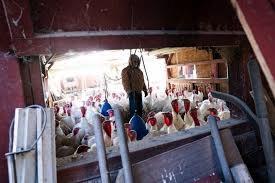
The USDA is “planning to discuss poultry vaccinations with trading partners amid concerns that other countries could restrict imports of vaccinated U.S. poultry”. There has been a groundswell supporting vaccination including endorsement by the World Organization for Animal Health. The World Health Organization is expressing concern over possible emergence of zoonotic avian influenza given the duration of the panornitic and the extension to a wide range of terrestrial and marine mammals.
Clearly the USDA has been negligent in not preemptively pursuing agreements relating to certification of products from vaccinated flocks destined for export as being free of avian influenza at the time of slaughter. PCR is readily available, and it is now possible to differentiate between vaccinated and infected flocks since there is no imperative to rely on serology as in decades past. Unfortunately, administrators are congenitally incapable of adapting policy to new technology or reversing positions in the face of new evidence.
It is questioned who is advising Secretary Vilsack and whether he is obtaining the best possible information based on current scientific and economic realities. It is possible that APHIS administrators are stuck in a 1990’s time warp and are hidebound by precedent and policy that inhibits consideration of practical and realistic alternatives. To their way of thinking, adoption of a limited industry-segment and regional vaccination program would represent a denial of previous decisions encompassed in the ‘whack-a-mole approach to control of HPAI applied during the 2022-2024 epornitic.

|
Governor Jim Pillen of Nebraska Reverses Position on Summer Feeding
|
02/14/2024 |
|
Governor Jim Pillen of Nebraska has reversed his previous decision and will now accept federal funds to assist families in need to feed children during the summer school vacation. His recent decision to accept $18 million in federal funds represents a reversal from his previous position. Governor Pillen stated previously that he did not believe in “welfare” which is somewhat hypocritical since according to news reports he accepted federal funding during the COVID pandemic for his hog plant.
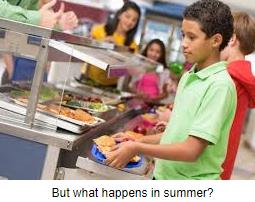
His acceptance of federal funding for supplemental feeding was in part attributed to a campaign in the Nebraska Legislature led by Senator Jen Day to override the decision by the Governor. In addition he was confronted by a petition signed by over 6,000 citizens of the state, protest vigils outside his residence and scathing criticism on social media.
Nebraska now becomes the 37th state in the Nation to accept funding that will benefit 150,000 children who qualify for reduced cost and free meals when school is in session.
Governor Pillen has apparently turned the situation to his advantage by announcing his flip-flop at a press conference joined by 21 state senators representing his party affiliation.
It is difficult to reconcile his statement that “children are the future of Nebraska” with a politically inspired refusal to accept Federal funds to alleviate hunger in a needy population. The question remains as to what motivated the original decision that appeared firm at the end of 2023? A disinclination to accept that there were needy children in Nebraska? A reluctance to accept funds from the Federal government perceived as politically inappropriate in a politically polarized environment? A realization that recipients would be from families denying him political support and therefore inconsequential?
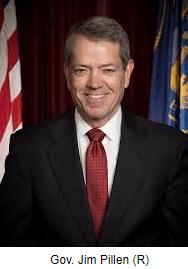 Irrespective of motivation, it is evident that Gov. Pillen has now made the correct decision having consulted with a range of advisors and visited with constituents. He may have been influenced by a recent poll showing state Senator Tony Vargas (D) runing neck-and-neck with incumbent Representative Don Bacon (R) who was previously considered to be a winner for reelection the right-leaning 2nd Congressional District. Whatever the influences on Gov. Pillen his reversal on supplemental feeding of children is correct and pragmatic. More power to him. Irrespective of motivation, it is evident that Gov. Pillen has now made the correct decision having consulted with a range of advisors and visited with constituents. He may have been influenced by a recent poll showing state Senator Tony Vargas (D) runing neck-and-neck with incumbent Representative Don Bacon (R) who was previously considered to be a winner for reelection the right-leaning 2nd Congressional District. Whatever the influences on Gov. Pillen his reversal on supplemental feeding of children is correct and pragmatic. More power to him.
It is a primary responsibility of governors, mayors and other elected officials to use the powers of their office to benefit all of their citizenry and to pay special attention to the less fortunate. Children need adequate food to grow and learn. Stunting physical and mental development through deprivation will in the long term be more expensive to communities than providing adequate nutrition.

|
The Kipster Concept – Applicability to the U.S. ?
|
02/05/2024 |
|
 In 2017 entrepreneurs in Holland led by Ruud Zanders established the Kipster concept to enhance both sustainability and the welfare of laying hens. The company established a supply agreement with Lidl to exclusively market eggs produced under the system. Market demand in the Netherlands at the time and the perception of required egg-attributes by the founders influenced the design of housing and the procedures selected to produce Kipster eggs. The prototype house incorporated solar panels, skylights and a combination of indoor aviary modules, and an “indoor garden” Two “outdoor gardens” on either side of the building allowed liberal space requirements. Design features in the building and equipment were incorporated to conserve energy. In 2017 entrepreneurs in Holland led by Ruud Zanders established the Kipster concept to enhance both sustainability and the welfare of laying hens. The company established a supply agreement with Lidl to exclusively market eggs produced under the system. Market demand in the Netherlands at the time and the perception of required egg-attributes by the founders influenced the design of housing and the procedures selected to produce Kipster eggs. The prototype house incorporated solar panels, skylights and a combination of indoor aviary modules, and an “indoor garden” Two “outdoor gardens” on either side of the building allowed liberal space requirements. Design features in the building and equipment were incorporated to conserve energy.
In keeping with the intent of the founders of Kipster, available recycled ingredients were specified for inclusion in feed for laying hens. This involved substitution of bakery waste for a proportion of corn and also meat and bone meal as a protein source (in the U.S.), sparing vegetable protein. In western Europe conventional diets include combinations of domestic and imported soybean meal, canola meal and sunflower meal as contributors to protein and hence amino acid requirements.
Based on prevailing sentiment in 2018, the Kipster concept required grow-out of cockerel chicks that would otherwise have been destroyed at the time that sister pullets were hatched. This requirement is now unnecessary in the E.U. given the advent of commercial gender-sorting of eggs bearing either male or female embryos at or before nine days of incubation. The requirement for grow-out of cockerels imposes additional cost and is contrary to optimal sustainability but is retained in the U.S. model.

In 2020, the Kroger Company obtained a franchise for the Kipster model in the U.S. Whether the Nation’s second-ranked retailer in egg sales actually evaluated the financial aspects in addition to marketing considerations is doubtful for other than a specialty niche. The question arises as to whether the claimed sustainability and welfare aspects are in reality recognized by consumers who will be willing to pay a premium for these non-quantifiable attributes. Will the Kipster image generate a preferential margin over the long term in comparison to available specialty eggs including nutritionally enriched, free range, pasture-reared and other variations?
The Purdue University Consumer Food Insights (Volume 2, issue 8) recently conducted a survey involving 2,500 respondents on their ranking of motivation to select specific food products. The Purdue University investigators applied conjoint analysis using orthogonal comparisons to differentiate among attributes and establish a real understanding of motivation. Using pork as an example, the relative weighting among 100 points leading to a purchase decision included:-
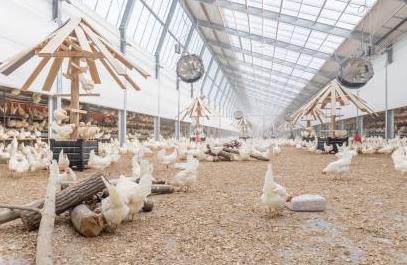
- Price, 23;
- Taste, 22;
- Freshness, 18;
- Nutritional value, 14;
- Appearance, 11;
- Welfare, 7;
- Sustainability, 5.
While it is acknowledged that the study was conducted on pork and not on eggs, the low ranking of both welfare and sustainability in relation to price and taste are noteworthy. Is it questioned whether Lidl in Holland or Kroger in the U.S. consider that a limited but affluent demographic will preferentially adopt the Kipster Brand that offers claimed welfare and sustainability in preference to competitive cage-free production systems. A second consideration is whether the presence of Kipster eggs in a store cooler provides a halo effect, extending the perception of added welfare and sustainability to conventional store-branded eggs?
The impression gained from the Kipster website and the history and adoption of the Kipster model suggests that a bottom-up approach was used by the developers to maximize sustainability and welfare as the bedrock of the concept. In contrast, a more realistic approach for the U.S. would have been to determine the needs of a broad range of consumers and adopt a system that satisfies the desired attributes of price, taste, freshness and nutritional value. This was the basis of the Nation’s widely accepted nationally distributed brand over 30 years ago.
In 2019 Kroger approached MPS Egg Farms, a large and progressive existing egg supplier, to establish a Kipster production unit in the U.S. The basic house as designed and erected in Holland was slightly modified. MPS erected and now operates four houses in North Manchester, Indiana. It is noted that in Holland there are only three Kipster houses currently producing eggs with the initial house on one farm and two houses on a second. The MPS farm with four houses effectively exceeds the number erected in Holland over a five-year period. This raises the question of whether the concept provides a satisfactory return that would have encouraged individual farmers and investors to adopt the model. The Kipster concept is reminiscent of the 2009 Rondeel Concept developed jointly by Vencomatic and Wageningen University. The system was widely promoted and supported by the Albert Heijn supermarket chain, a subsidiary of Ahold-Delhaize. Only a handful of Rondeel units were erected and placed into production.
The MPS Kipster complex comprises four houses each holding 24,000 hens. Each house comprises two longitudinal ‘night-time’ areas with total of 24,212 square feet allowing 1.01 square foot per hen. An “indoor garden” 358 by 33 feet allowing 1.00 square foot per hen is located midway in the house between the night-time areas. Drop-down doors can be closed to confine flocks to the two “night-time” areas The ‘indoor garden has skylights for natural daylight and incorporates artificial trees for roosting, hay-bales and other enrichments on a base of wood shavings. Two “outdoor gardens” are provided each 32 feet wide parallel with each side of the house providing 1.0 square feet of exterior access per bird. The enclosed area of a Kipster house provides 1.61 square feet per hen and the outside area comprises 0.94 square feet.
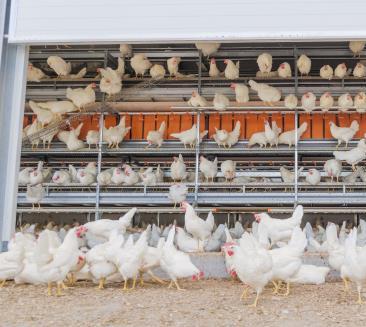 The ‘night-time’ areas are equipped with Big Dutchman Natura® Step Cages equipped with feeders and nipple drinkers. The communal nest system incorporates tilting floors, center rollaway collection and additional side belts for system-laid eggs to optimize the yield of clean shells. Big Dutchman provided an OptiSec Manure Drying System that contributes to sustainability by reducing the moisture content of manure to 10 to 15 percent depending on ambient temperature. Big Dutchman also supplied an Innoplus Exhaust Air Scrubber to remove dust and odors from the exhaust stream consistent with western European requirements, although of questionable need for the U.S. The ‘night-time’ areas are equipped with Big Dutchman Natura® Step Cages equipped with feeders and nipple drinkers. The communal nest system incorporates tilting floors, center rollaway collection and additional side belts for system-laid eggs to optimize the yield of clean shells. Big Dutchman provided an OptiSec Manure Drying System that contributes to sustainability by reducing the moisture content of manure to 10 to 15 percent depending on ambient temperature. Big Dutchman also supplied an Innoplus Exhaust Air Scrubber to remove dust and odors from the exhaust stream consistent with western European requirements, although of questionable need for the U.S.
According to Sam Krouse CEO of MPS, performance from the initial placements is comparable with aviaries and other cage-free systems. With acceptable U.S. production parameters, average output is 200 cases per day. Neither capital investment per hen nor production costs including feed, labor and power have been disclosed. Estimates of capital costs suggest a higher unit price per hen compared a conventional aviary system operated at UEP density. Any differential will be reflected in the fixed component of production costs. It is noted that the entire farm of four houses is effectively equivalent to one level of a typical U.S. multi-level (two to four) aviary house with a single foundation and roof. Labor cost is proportionately higher with four relatively small houses compared to an in-line aviary house. There is no indication of the price of feed that is a major component of variable cost. Bakery waste with xylanase and amino acid supplementation would probably be equivalent in price to corn. Animal byproduct meal is included in laying diets based on the need to incorporate “recycled ingredients”. There is a decided consumer preference for all-vegetable diets that has become the standard for U.S. specialty eggs.
It is frequently difficult to transfer concepts that may be acceptable and financially beneficial at a point in time in a nation to a completely different operating and marketing environment without considerable adaptation and a required degree of flexibility. A few years ago the significant U.S. marketer of specialty eggs was approached by a consortium of Japanese producers to license the concept for their nation. Investigation of the needs of the market in Japan, prevailing production costs and numerous technical restraints that emerged required such extensive modification of the U.S. program that the initiative was abandoned.
While it is too early to evaluate the Kipster concept with respect to the U.S. it certainly has not blown out the doors in Holland over the past five years. Development of the system in a highly competitive market such as the U.S. will probably confine adoption to a specific niche. Based on current consumer motivation, any novel U.S. egg concept would rank price, commensurate with quality and freshness above the attributes of sustainability and welfare. Nutritional value and safety would also be highly ranked. Accordingly, the structure of an enterprise, the design of housing, specification of equipment, formulation and sourcing of feed and selection of packaging would all be conditioned by the needs of the market.
At the end of the day Kroger could not have picked a better partner than MPS to develop the first Kipster operation in the U.S. The question remains as to how both Kipster and their licensee Kroger, will expand the concept to supply other U.S. regions with eggs. There is no indication of how Kroger will promote sustainability and welfare against USDA certified organic and other cage-free and pasture-housed products. It is also questioned whether Kroger will be willing to pay a premium to producers to cover the additional fixed and variable costs of nest-run production in comparison to alternative cage-free housing systems. Certainly if margins justify the difference over the intermediate term but unless either Kroger or Kipster are willing to spend on promoting the concept on mainstream and social media growth will be limited in a competitive market.

|
Corn Ethanol is a Wasteful Source of Energy
|
01/31/2024 |
|
 Tom Philpott writing in the January 19th edition of The New Republic documented the fallacy of corn-based ethanol as a sustainable source of energy. During the energy crisis of the 1970’s, the concept of using corn as a substrate to produce ethanol was initiated. The industry grew slowly given that ethanol had to compete with petroleum products on a level playing field. In 2007, the Renewable Fuel Standard was developed essentially to make the U.S. independent of oil supplied by ‘unfriendly’ nations. According to Philpott, in 2004 eleven percent of corn was converted to ethanol and byproducts. This proportion has increased to a projection of 32 percent of the 2024 crop. Tom Philpott writing in the January 19th edition of The New Republic documented the fallacy of corn-based ethanol as a sustainable source of energy. During the energy crisis of the 1970’s, the concept of using corn as a substrate to produce ethanol was initiated. The industry grew slowly given that ethanol had to compete with petroleum products on a level playing field. In 2007, the Renewable Fuel Standard was developed essentially to make the U.S. independent of oil supplied by ‘unfriendly’ nations. According to Philpott, in 2004 eleven percent of corn was converted to ethanol and byproducts. This proportion has increased to a projection of 32 percent of the 2024 crop.
There is no issue that unites both Republican and Democratic legislators from corn-producing states than preserving and extending the Renewable Fuel Standard. Without the mandated diversion of approximately 5 billion bushels of corn to ethanol, the price for the commodity would be far lower, possibly under the cost of production and accordingly reducing output in addition to maintaining the artificially high value of cropland.
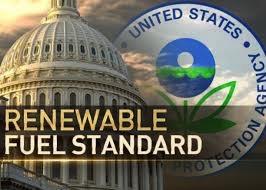 Every bushel of fermented corn produces one-third each of ethanol, dried distillers solubles and carbon dioxide, a greenhouse gas. At this time, carbon dioxide should be sequestered on site subject to suitability of the ground on which the plant is located. Plans to install a web of pipelines to transport carbon dioxide from plants to a disposal site in North Dakota have been scuttled by the very farmers who benefit from ethanol production but reject the environmental effects of their crop. Every bushel of fermented corn produces one-third each of ethanol, dried distillers solubles and carbon dioxide, a greenhouse gas. At this time, carbon dioxide should be sequestered on site subject to suitability of the ground on which the plant is located. Plans to install a web of pipelines to transport carbon dioxide from plants to a disposal site in North Dakota have been scuttled by the very farmers who benefit from ethanol production but reject the environmental effects of their crop.
Although ethanol is quoted on the Chicago Mercantile Exchange, it does not trade due to indifference to the commodity. Exports represent less than ten percent of production amounting to approximately one million barrels per day. Attempts to increase demand by marketing higher gasoline blends exceeding ten percent would appear to have languished due to the high cost of installing multi-blend fuel pumps at filling stations and the inability of older vehicles to run on more than a ten percent ethanol content.
The ethanol industry is justifiably concerned over the rise in EV adoption although sales of these vehicles have leveled in the U.S. As more charging points are installed in both homes and for public use in accordance with current federal climate-mitigation policy, the demand for ethanol will shrink.
Claims that ethanol is “clean burning” are fallacious. Even with E-15 blend, 85 percent of fuel used to power a vehicle comprises gasoline. Studies that take into account all of the energy inputs to grow and harvest corn and convert the product to ethanol suggest that there is no net energy saving but that carbon dioxide produced is detrimental to the environment if vented. The quantity of water required for cooling bioreactors is immense, occassionaly depleting aquifers in the vicinity of plants.
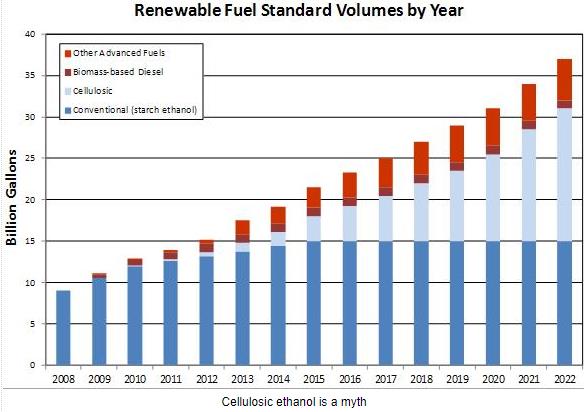 |
According to the 2023 Iowa Climate Statement accepted by 200 scientists in over 30 colleges and universities, a one-acre solar farm produces as much energy as 100 acres of corn-based ethanol. The problem of large arrays displacing corn production relates to deficiencies in the grid. If energy from solar arrays is available to charge EV’s energy utilization is highly efficient since electric vehicles convert over 90 percent of energy to motion compared to internal combustion engines with an efficiency of less than 25 percent.
Government policy on ethanol that may have been justifiable at the turn of the century is now a liability. The RFS represents an indirect tax on all who travel and eat. In millennia to come, archeologists will wonder at the inhabitants of the Midwest who apparently worshiped large tanks much as the Druids erect Stonehenge and the ancient Egyptians erected their pyramids and obelisks.
Unfortunately, ethanol has acquired a momentum that is now impossible to restrain notwithstanding distortion of the agro-economy. Ethanol is maintained by the mendacity of politicians supported by the ethanol industry and their constituents at the cost of all consumers in common with livestock and poultry producers.

|
|
|
|
View More
|
Top
|
|